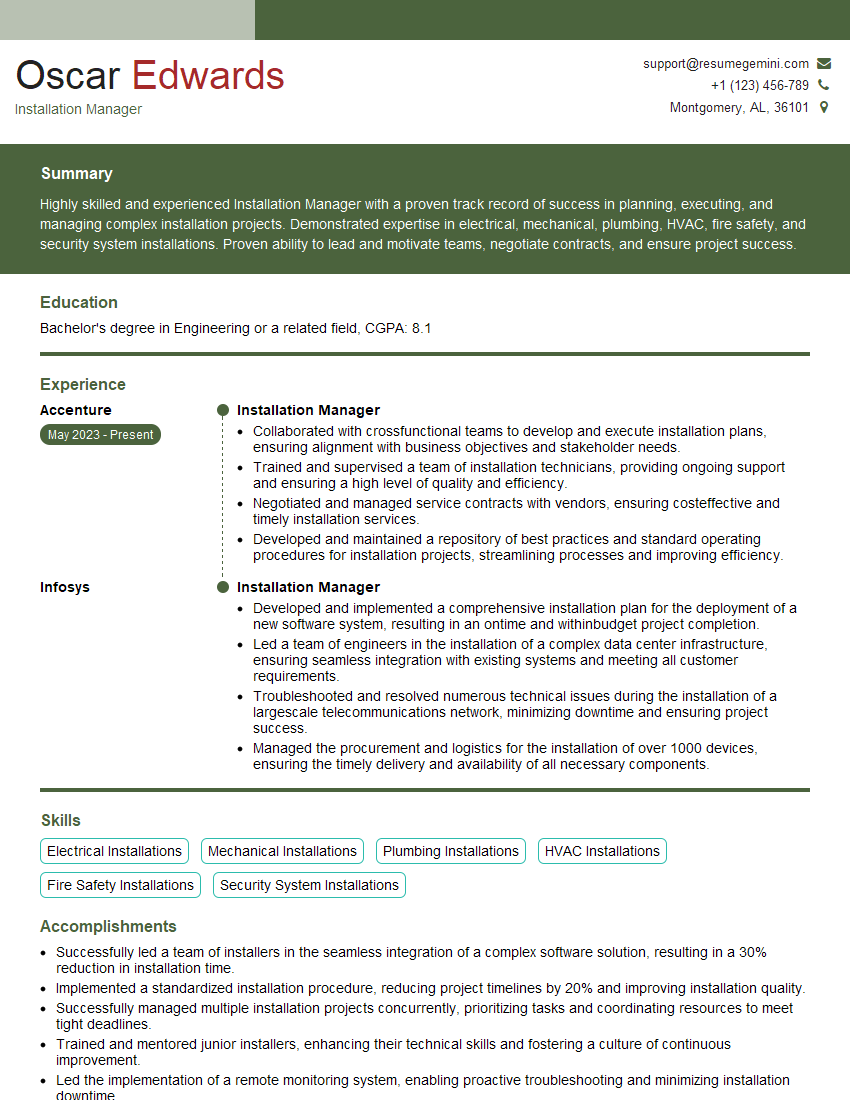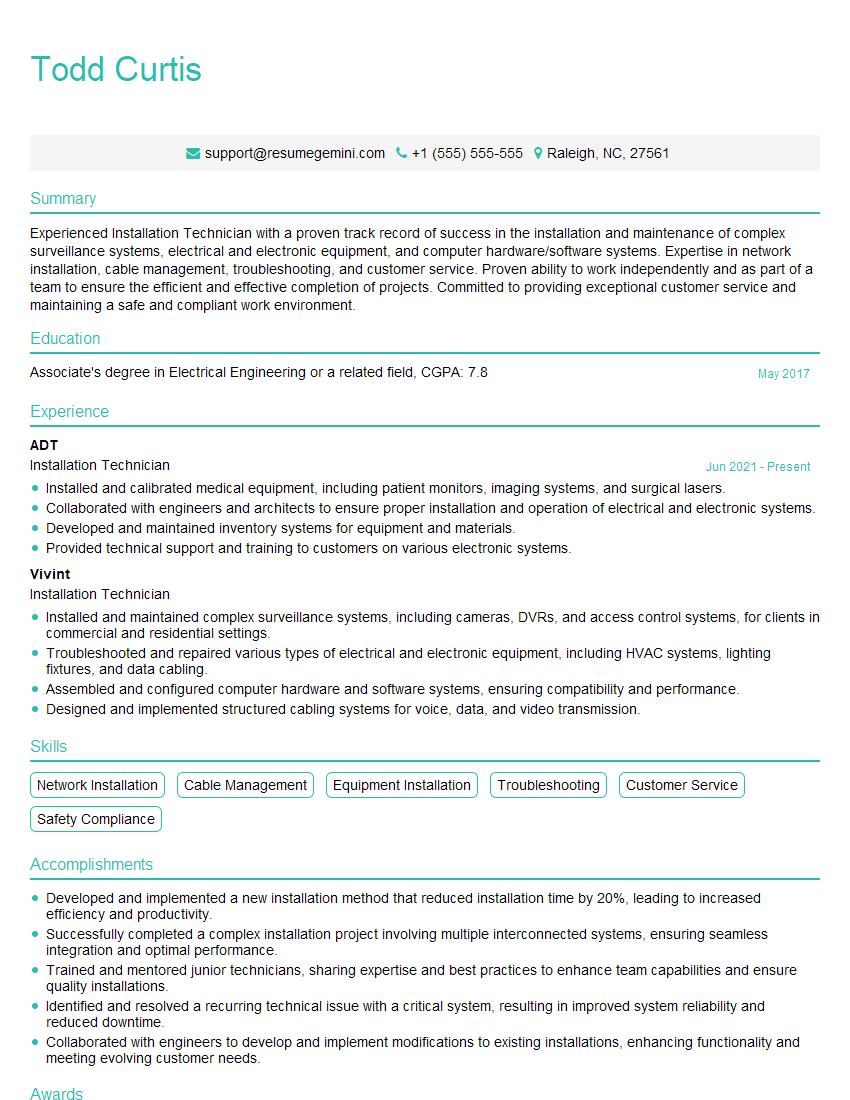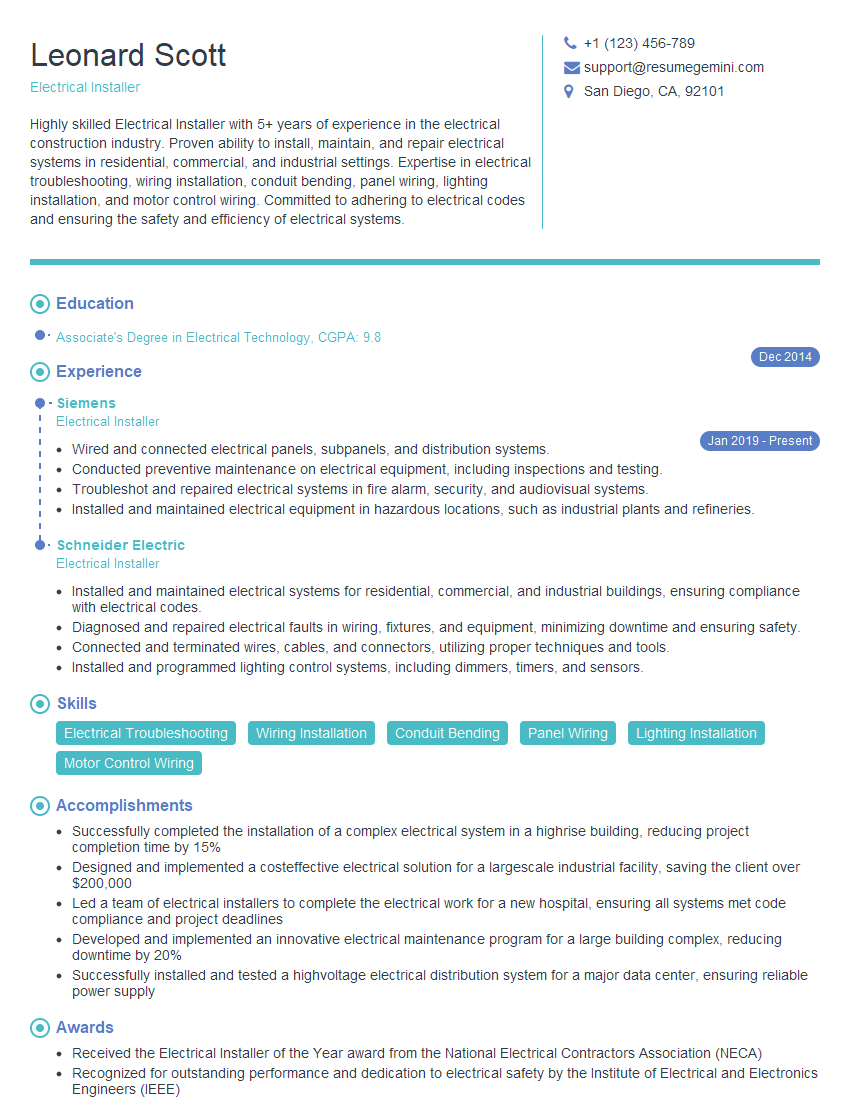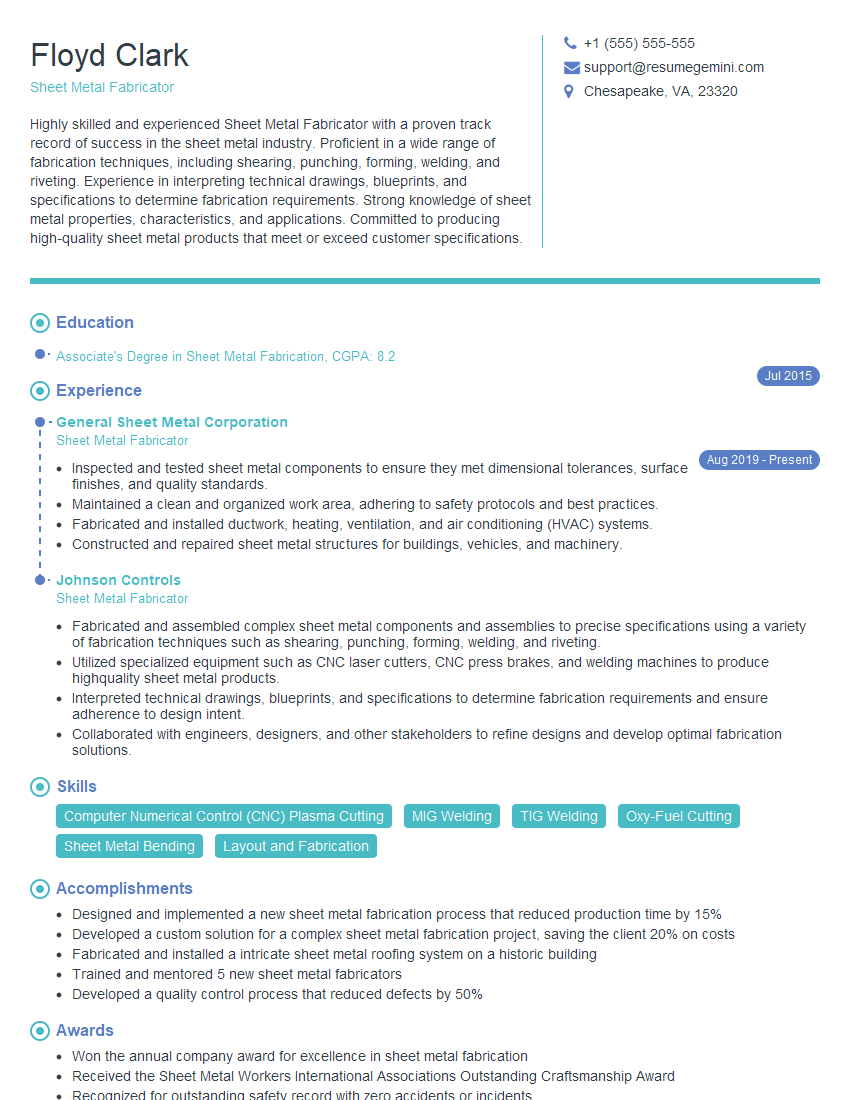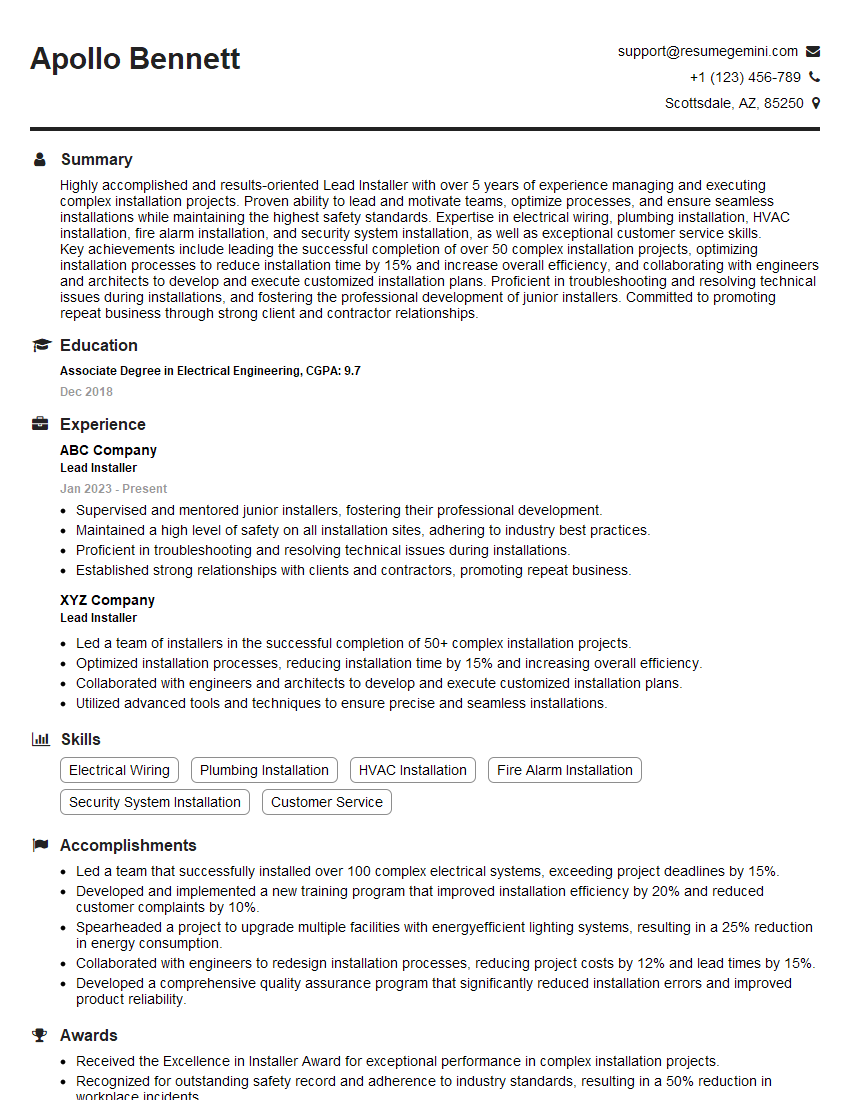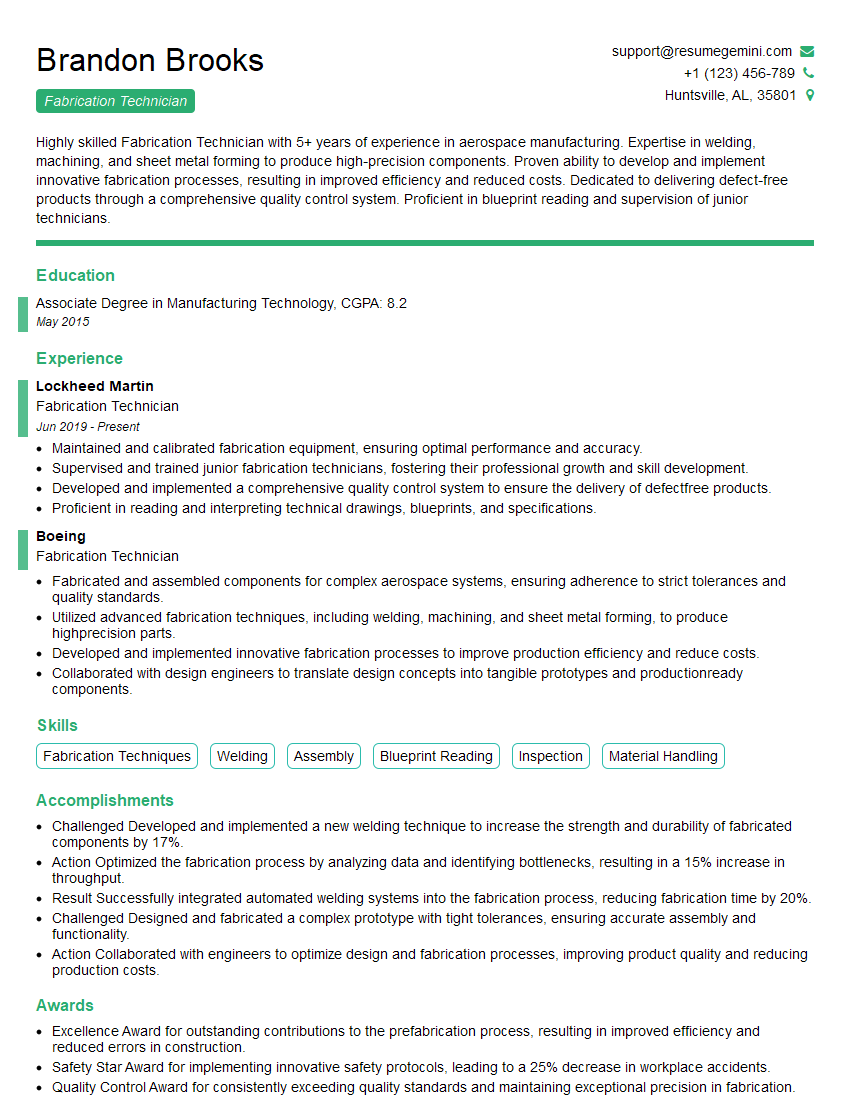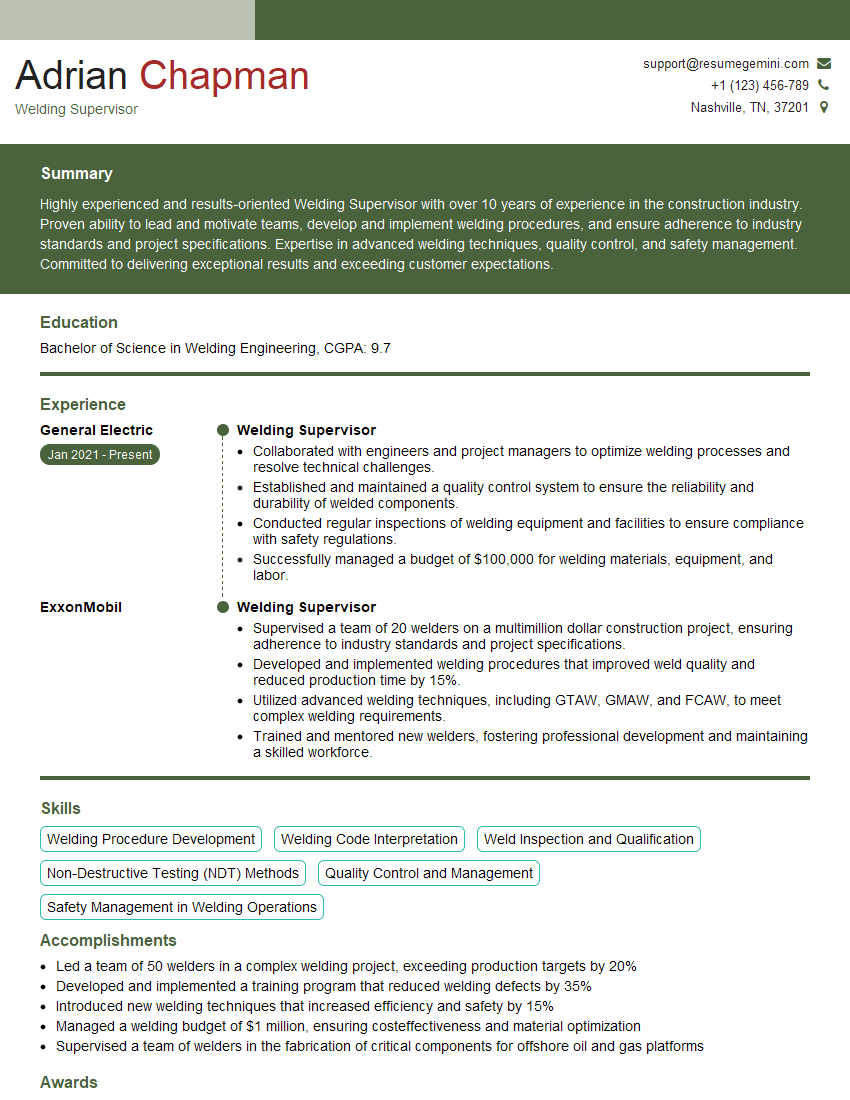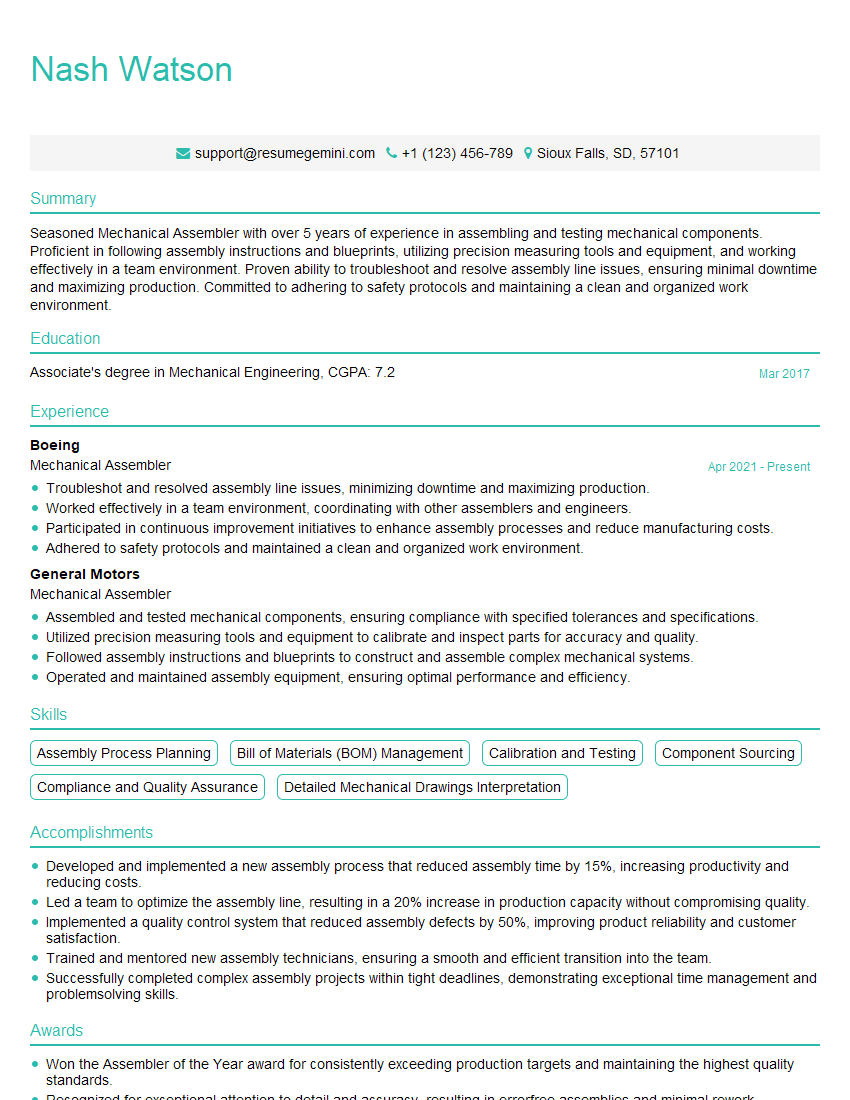Unlock your full potential by mastering the most common Fabrication and Installation interview questions. This blog offers a deep dive into the critical topics, ensuring you’re not only prepared to answer but to excel. With these insights, you’ll approach your interview with clarity and confidence.
Questions Asked in Fabrication and Installation Interview
Q 1. Describe your experience with different welding techniques (MIG, TIG, Stick).
My experience encompasses a wide range of welding techniques, with significant proficiency in MIG (Metal Inert Gas), TIG (Tungsten Inert Gas), and Stick (Shielded Metal Arc Welding) welding. Each process serves a unique purpose depending on the material and the desired weld quality.
MIG Welding: I’m highly skilled in MIG welding, known for its speed and efficiency in joining ferrous metals. I frequently use it for large-scale projects requiring quick turnaround times, such as fabricating steel structures. For example, I recently used MIG welding to construct a complex framework for a new industrial building, completing the task within the scheduled timeframe and maintaining high quality.
TIG Welding: TIG welding provides exceptional precision and control, ideal for thin materials and applications requiring a clean, aesthetically pleasing weld. I frequently use TIG welding for aluminum and stainless steel components, where the weld’s appearance and structural integrity are critical. A recent project involved TIG welding intricate stainless steel piping for a pharmaceutical plant, demanding precision and a high level of cleanliness.
Stick Welding: Stick welding, while less precise than MIG or TIG, offers portability and works well in outdoor environments with limited power access. It’s useful for heavier gauge materials and repairs in challenging locations. I utilized stick welding during an on-site repair of a damaged steel support beam in a remote location where power was limited.
Q 2. Explain your understanding of blueprint reading and fabrication drawings.
Blueprint reading and understanding fabrication drawings are fundamental to my work. It’s like deciphering a map that guides the entire fabrication process. I’m proficient in interpreting various types of drawings, including orthographic projections, isometric views, and detailed assembly drawings.
My process involves thoroughly reviewing the drawings to understand the dimensions, tolerances, material specifications, and assembly procedures. I pay close attention to details such as weld symbols, surface finishes, and any special instructions. I frequently use annotation tools to highlight crucial elements and cross-reference dimensions to ensure accuracy. If any ambiguities arise, I promptly communicate with the engineering team to clarify requirements before starting work, preventing costly errors down the line.
For instance, a recent project involved a complex assembly requiring the precise alignment of multiple components. By meticulously reviewing the isometric drawings and understanding the dimensional tolerances, I successfully fabricated and assembled the components, resulting in a flawless final product.
Q 3. How do you ensure the quality and accuracy of your work during fabrication?
Quality and accuracy are paramount in fabrication. I employ a multi-faceted approach, starting with meticulous planning and material selection. This involves verifying material specifications, performing accurate measurements, and double-checking all dimensions before any cutting or welding begins.
Regular Inspection: Throughout the fabrication process, I conduct regular inspections, using precision measuring tools such as calipers, micrometers, and levels to ensure adherence to specifications. This allows me to identify and correct minor errors promptly, preventing larger problems later.
Welding Procedures: I meticulously follow established welding procedures, including proper joint preparation, correct welding parameters, and post-weld cleaning. I also use various non-destructive testing (NDT) methods, such as visual inspection and magnetic particle testing, to identify any potential flaws.
Documentation: Detailed documentation of each step is crucial. This includes recording measurements, material traceability, and inspection results. This systematic approach ensures accountability and allows for easy tracking of the fabrication process.
For example, in a recent project constructing a stainless steel tank, thorough inspections during each stage, including cutting, welding, and assembly, prevented a small misalignment early on from escalating into a significant defect.
Q 4. What safety precautions do you follow during fabrication and installation?
Safety is my top priority. I strictly adhere to all relevant safety regulations and company policies, including the use of appropriate personal protective equipment (PPE) and following established safety procedures.
PPE: This includes wearing safety glasses, welding helmets with appropriate shade lenses, flame-resistant clothing, gloves, and safety shoes. I also ensure the work area is well-ventilated, especially during welding, to mitigate the risk of fume inhalation.
Fire Prevention: I maintain a clean and organized work area, removing any flammable materials from the vicinity of welding operations. I have fire extinguishers readily accessible and am trained in their proper use.
Lockout/Tagout Procedures: When working with machinery, I always follow lockout/tagout procedures to ensure the equipment is safely de-energized before any maintenance or repair work.
Emergency Procedures: I am familiar with emergency procedures and know how to respond to various hazards, such as electrical shocks, burns, or equipment malfunctions.
Regular safety training and adherence to safety protocols are essential for preventing accidents and creating a safe work environment. Safety is not just a set of rules; it’s a mindset that informs every decision I make on the job.
Q 5. Describe your experience with CNC machining and programming.
I have extensive experience with CNC machining and programming. My skills include operating various CNC machines such as mills and lathes, as well as programming them using CAM software such as Mastercam and Fusion 360.
I’m proficient in creating CNC programs from 3D models and 2D drawings. This involves selecting appropriate cutting tools, defining cutting parameters (feed rate, spindle speed, depth of cut), and simulating the program to identify and correct potential errors before machining. I can also program complex machining operations, including multi-axis milling and turning, to create intricate parts.
For example, I recently used a CNC mill to machine a series of high-precision aluminum parts for a medical device. By carefully programming the machine and using appropriate tooling, I was able to achieve the required tolerances and surface finishes while maintaining high productivity.
Q 6. How do you troubleshoot and resolve issues during the installation process?
Troubleshooting during installation requires a systematic and analytical approach. My process starts with carefully reviewing the installation drawings and specifications to identify the source of the problem.
Visual Inspection: I begin with a thorough visual inspection, checking for any obvious issues such as misalignments, loose connections, or damaged components.
Systematic Testing: I then conduct systematic testing, checking individual components and connections to identify the faulty part or system. This may involve using testing equipment such as multimeters or pressure gauges.
Documentation: I maintain detailed records of all troubleshooting steps, including the problem description, tests performed, and corrective actions taken. This helps prevent similar issues from occurring in the future and assists in communication with the engineering team.
Collaboration: If I can’t resolve an issue independently, I collaborate with colleagues or engineers to find a solution. Open communication and teamwork are crucial for effectively resolving complex installation problems.
For example, during a recent installation of a complex piping system, I encountered a pressure leak. By systematically testing each section of the piping, I identified a faulty weld, which I then repaired, restoring the system’s functionality.
Q 7. What experience do you have with different materials (steel, aluminum, etc.)?
My experience spans a wide range of materials, including steel (carbon steel, stainless steel), aluminum, and various other metals and alloys. Each material requires a different approach to fabrication and welding, and I’m adept at selecting the appropriate techniques and tools for each.
Steel: I have extensive experience with various types of steel, from mild steel to high-strength alloys. I’m familiar with different steel grades and their properties, allowing me to choose the right material for the application and weld it using appropriate techniques.
Aluminum: Aluminum requires specialized welding techniques (TIG is often preferred) and careful handling due to its tendency to oxidize. I have significant experience in fabricating and welding aluminum components, ensuring strong and corrosion-resistant joints.
Other Materials: I also have experience working with other materials such as copper, brass, and various plastics, adapting my techniques as needed. Understanding material properties and selecting the correct methods is critical for achieving a quality outcome.
Adaptability is key. Whether it’s a complex steel structure or a delicate aluminum part, my experience allows me to select the right tools, techniques, and procedures to ensure a high-quality, safe, and efficient outcome.
Q 8. Describe your experience with different types of fasteners and joining methods.
My experience encompasses a wide range of fasteners and joining methods, crucial for ensuring structural integrity and aesthetic appeal in fabrication and installation. This includes everything from basic mechanical fasteners to more specialized techniques.
Mechanical Fasteners: I’m proficient with bolts (various types like hex head, carriage bolts, etc.), screws (machine screws, self-tapping screws, wood screws), rivets, and nails. The choice depends heavily on the materials being joined, the required strength, and the accessibility of the joint. For example, when working with steel structures, high-strength bolts are preferred for their superior load-bearing capacity compared to welds in some situations. In woodworking, I’d select screws or dowels depending on the project’s aesthetic and load requirements.
Welding: I have extensive experience in various welding techniques, including MIG (Metal Inert Gas), TIG (Tungsten Inert Gas), and stick welding. The choice of welding method depends on the base metal, desired weld quality, and access. For instance, TIG welding provides a cleaner, more precise weld ideal for thin materials and visible joints, while MIG welding offers faster production speeds for larger structures.
Adhesives: I’m familiar with structural adhesives, epoxies, and other bonding agents. These are particularly useful for joining dissimilar materials or where mechanical fasteners aren’t feasible. I always carefully consider the adhesive’s compatibility with the materials involved and the environmental conditions.
Other Joining Methods: My experience also extends to techniques like soldering, brazing, and crimping, each suited for specific applications and material types.
Throughout my career, I’ve consistently selected the optimal joining method based on a thorough assessment of the project’s requirements, ensuring both functionality and safety.
Q 9. How do you manage your time and prioritize tasks in a fast-paced environment?
Managing time and prioritizing tasks in a fast-paced fabrication and installation environment requires a structured approach. I utilize several strategies to maintain efficiency and meet deadlines.
Project Breakdown: I begin by meticulously breaking down large projects into smaller, manageable tasks. This allows for better tracking of progress and identification of potential bottlenecks.
Prioritization Matrix: I use a prioritization matrix (like Eisenhower Matrix) to categorize tasks based on urgency and importance. This helps focus on the most critical tasks first, ensuring timely completion of essential elements.
Time Blocking: I allocate specific time blocks for different tasks, preventing multitasking and improving focus. This disciplined approach significantly boosts productivity.
Regular Monitoring: I regularly review my progress against the schedule, making adjustments as needed. This proactive approach allows for quick responses to unexpected delays.
Teamwork & Communication: Effective communication with my team is key. Openly discussing challenges and potential roadblocks ensures that everyone is aligned and working towards common goals.
For example, during a recent large-scale installation project with a tight deadline, I successfully utilized this system, resulting in the timely and efficient completion of the project, despite unforeseen material delays.
Q 10. Explain your experience with working from technical specifications and drawings.
Working from technical specifications and drawings is fundamental to my work. I’m adept at interpreting complex blueprints, schematics, and detailed specifications to ensure accurate fabrication and installation.
Blueprint Interpretation: I thoroughly review all drawings, including dimensions, tolerances, material specifications, and assembly instructions. I pay close attention to details like annotations and revision marks to ensure accuracy.
Material Selection: I verify that the materials used correspond exactly to the specifications. This is crucial for structural integrity and meeting project requirements.
Tolerance Management: I understand and adhere to specified tolerances, ensuring that all components fit precisely and function correctly. This requires a keen eye for detail and precise measurement techniques.
Collaboration: When ambiguities arise, I proactively engage with engineers or designers to clarify instructions, ensuring that all team members share the same understanding of the project’s requirements.
In a recent project involving custom-fabricated metalwork, my ability to accurately interpret detailed engineering drawings ensured the perfect fit of complex components, leading to a flawless installation.
Q 11. How do you handle unexpected challenges or problems during a project?
Unexpected challenges are inevitable in fabrication and installation. My approach involves a systematic problem-solving process.
Assessment: The first step is to thoroughly assess the nature of the problem, identifying its root cause and potential impact on the project.
Risk Evaluation: I evaluate the risks associated with the problem, considering potential consequences and safety implications.
Solution Development: I brainstorm potential solutions, weighing the pros and cons of each approach. This often involves consulting relevant codes and standards to ensure compliance.
Implementation: Once a suitable solution is identified, I implement it efficiently, ensuring safety and minimizing further delays.
Documentation: I meticulously document the problem, the solution implemented, and the lessons learned. This helps prevent similar issues in future projects.
For instance, during a recent installation, a crucial component arrived damaged. I swiftly assessed the damage, explored various solutions, opted for a temporary fix to meet the deadline, and initiated a replacement order while minimizing disruption to the project timeline.
Q 12. What is your experience with quality control processes in fabrication and installation?
Quality control is paramount in fabrication and installation. My experience includes implementing and adhering to rigorous quality control processes throughout the entire project lifecycle.
Material Inspection: I inspect all incoming materials to ensure they meet the specified quality standards. This often includes checking dimensions, surface finish, and material properties.
In-Process Inspection: During fabrication, I perform regular inspections to identify and rectify defects early. This prevents errors from propagating to later stages of the project.
Dimensional Control: I utilize precision measuring tools to ensure that all components are fabricated to the correct dimensions and tolerances.
Final Inspection: A thorough final inspection is conducted before installation, verifying that all components meet quality standards and are ready for installation.
Documentation: All inspection results are meticulously documented, providing a complete audit trail for traceability and future reference.
In my previous role, the implementation of a robust quality control system resulted in a significant reduction in defects and rework, ultimately leading to cost savings and improved customer satisfaction.
Q 13. Describe your experience with using measuring tools and equipment.
Proficiency with measuring tools and equipment is essential for accurate fabrication and installation. I’m experienced with a wide variety of tools.
Measuring Tapes: I routinely use measuring tapes for quick linear measurements, ensuring accuracy through proper techniques.
Steel Rules: These provide precise measurements, especially for smaller components.
Verniers and Micrometers: For extremely precise measurements, I rely on verniers and micrometers, which offer higher accuracy than standard rulers.
Levels: Levels are crucial for ensuring proper alignment and plumbness during installation.
Squares and Protractors: These are essential for checking angles and ensuring accurate cuts.
Digital Measuring Tools: I use digital calipers and laser measuring tools for efficient and accurate measurements, especially in large or difficult-to-access areas.
My skills extend beyond just using these tools; I understand their limitations and choose the appropriate tool for the task at hand, ensuring the accuracy of every measurement.
Q 14. How do you ensure proper alignment and fit during installation?
Ensuring proper alignment and fit during installation is crucial for both functionality and aesthetics. My approach combines careful planning and precise execution.
Pre-Installation Planning: I thoroughly review the installation plans, ensuring I understand the sequence of assembly and potential challenges.
Accurate Measurements: Precise measurements are taken at every stage of the installation process to verify alignment and fit.
Shimming and Adjustment: Where necessary, I use shims or other adjustment techniques to ensure perfect alignment, often requiring iterative adjustments.
Leveling and Plumbness: Levels and plumb bobs are used to ensure that components are installed perfectly level and plumb.
Temporary Supports: Temporary supports are used to hold components in place until they are permanently secured.
Quality Checks: Regular quality checks are performed throughout the installation process to identify and correct any misalignments or fitting issues promptly.
For example, during the installation of a large, complex piece of machinery, my meticulous attention to alignment using laser levels and shims ensured that all components were perfectly aligned, resulting in smooth operation and a high-quality installation.
Q 15. What software are you proficient in (CAD, CAM, etc.)?
My proficiency in CAD/CAM software is extensive. I’m highly skilled in AutoCAD, SolidWorks, and Mastercam. AutoCAD is my go-to for 2D drafting and detailed drawings, crucial for creating precise fabrication plans. SolidWorks allows me to create and manipulate 3D models, enabling better visualization and analysis of complex designs before fabrication. Mastercam is essential for programming CNC machines, ensuring efficient and accurate cutting, milling, and other machining processes. For example, in a recent project involving the fabrication of a custom stainless steel enclosure, I used SolidWorks to design the enclosure, ensuring proper fit and functionality, then used Mastercam to program the CNC machine to cut the sheet metal with precision. The result was a perfect, ready-to-install enclosure.
Career Expert Tips:
- Ace those interviews! Prepare effectively by reviewing the Top 50 Most Common Interview Questions on ResumeGemini.
- Navigate your job search with confidence! Explore a wide range of Career Tips on ResumeGemini. Learn about common challenges and recommendations to overcome them.
- Craft the perfect resume! Master the Art of Resume Writing with ResumeGemini’s guide. Showcase your unique qualifications and achievements effectively.
- Don’t miss out on holiday savings! Build your dream resume with ResumeGemini’s ATS optimized templates.
Q 16. Explain your experience with working in a team environment.
Teamwork is fundamental in fabrication and installation. I thrive in collaborative environments. My experience includes working with diverse teams comprising engineers, designers, welders, machinists, and installation crews. I believe in clear communication, active listening, and a shared understanding of project goals. For example, on a large-scale project involving the construction of a custom-designed metal staircase, I worked closely with the design team to ensure the fabrication plans accurately reflected their vision. Then, I coordinated with the installation team to provide guidance on the most efficient and safe installation method. This collaborative approach ensured the project was completed on time and within budget.
Q 17. How do you manage inventory and material handling?
Efficient inventory and material handling are critical for project success. I utilize a combination of methods, including a robust inventory management system (often software-based), regular stock checks, and a well-organized storage system. This minimizes waste and ensures materials are readily available when needed. For material handling, I employ safe and efficient techniques, considering factors like material weight, fragility, and dimensions. This includes using appropriate lifting equipment, such as forklifts or cranes when necessary and adhering to all safety protocols. Think of it like running a well-oiled machine: every part needs to be in its place at the right time. In one instance, we implemented a Kanban system to optimize material flow, resulting in a 15% reduction in lead times and material waste.
Q 18. What is your experience with different types of installation methods?
My experience spans various installation methods, including bolting, welding, riveting, adhesive bonding, and more. The choice of method depends on factors like material properties, project requirements, and environmental considerations. For instance, bolting is suitable for quick and easy assembly, while welding provides superior strength and durability. I’ve worked extensively on projects that involved installing components using a combination of techniques; one project involved installing large structural steel beams using a combination of bolting and welding for optimal strength and efficiency. I’m familiar with both in-situ and pre-fabricated installation methods, and my selection always prioritizes safety and precision.
Q 19. Describe your experience with preventative maintenance of fabrication equipment.
Preventative maintenance is key to extending the lifespan and ensuring the reliable operation of fabrication equipment. My approach involves a scheduled maintenance program including regular inspections, lubrication, cleaning, and component replacements as needed. This requires an understanding of each machine’s operation and potential points of failure. I meticulously document all maintenance activities, noting any issues or needed repairs. This proactive approach helps to prevent costly downtime and ensures worker safety. I recently implemented a predictive maintenance program using sensor data to monitor machine performance, allowing us to anticipate potential problems and schedule maintenance before major breakdowns occurred.
Q 20. How do you ensure compliance with safety regulations and industry standards?
Safety is paramount. I rigorously adhere to OSHA regulations and other relevant industry standards. This includes implementing safety protocols, using appropriate personal protective equipment (PPE), and conducting regular safety training for myself and my team. Before starting any project, we perform a thorough risk assessment to identify potential hazards and develop mitigation strategies. Every step, from material handling to equipment operation to installation, follows strict safety procedures. For example, we always use fall protection systems during high-altitude installations and ensure all machinery is properly guarded. A safe work environment fosters productivity and prevents accidents.
Q 21. Explain your experience with interpreting and applying engineering specifications.
Interpreting and applying engineering specifications is a core competency. I’m adept at reading and understanding engineering drawings, specifications, and related documentation. This involves paying close attention to details such as dimensions, tolerances, material requirements, and finishing specifications. I possess the ability to translate those specifications into practical fabrication and installation procedures. For example, in a recent project involving the fabrication of a custom-designed pressure vessel, I carefully studied the engineering drawings and specifications to ensure the vessel met all pressure and safety requirements before initiating the fabrication process. My attention to detail ensures that the final product perfectly matches the design.
Q 22. How do you handle discrepancies between drawings and actual site conditions?
Discrepancies between drawings and site conditions are a common challenge in fabrication and installation. My approach is systematic and involves several key steps. First, I meticulously document the discrepancies using photos, sketches, and detailed notes. This creates a clear record for future reference and facilitates communication with the design team and project stakeholders. Second, I carefully analyze the nature of the discrepancy. Is it a minor dimensional difference that can be easily accommodated, or is it a major conflict requiring redesign? Third, I propose solutions, prioritizing those that maintain the integrity of the design while minimizing disruption and extra costs. This might involve minor adjustments on-site, creating custom solutions, or consulting with the architect/engineer for revised drawings. For example, on a recent project, the foundation for a prefabricated steel structure was slightly misaligned. Instead of rejecting the entire structure, we meticulously adjusted the base plates on-site, documenting all changes with photos and measurement records. This saved significant time and resources.
Q 23. Describe your experience with troubleshooting electrical or mechanical systems.
Troubleshooting electrical or mechanical systems requires a methodical approach. I begin by gathering information: reviewing schematics, inspecting the system, and conducting basic tests to identify the affected area. For instance, if a pump isn’t functioning, I’d check power supply, fuses, wiring, the pump itself, and control systems. I then employ systematic diagnostics using multimeters, thermal cameras, and other relevant testing equipment. My experience includes identifying and resolving issues with hydraulic systems, pneumatic controls, and various types of electric motors. A particular challenge involved tracing a faulty wire within a complex wiring loom in a large industrial machine. By systematically removing sections of the loom and testing continuity, I eventually pinpointed the broken wire, avoiding complete system replacement.
Q 24. How do you use problem-solving techniques to overcome fabrication challenges?
Overcoming fabrication challenges often involves employing a structured problem-solving approach. I typically use a variation of the ‘5 Whys’ technique, repeatedly asking ‘why’ to uncover the root cause of a problem. For instance, if a weld isn’t meeting specifications, I’d ask: Why is the weld weak? (Insufficient penetration). Why is there insufficient penetration? (Incorrect welding parameters). Why are the welding parameters incorrect? (Improper machine calibration). This iterative questioning helps uncover hidden problems. I also rely on root cause analysis techniques like fishbone diagrams to identify contributing factors. In one project, we experienced repeated cracking in a certain component. Root cause analysis revealed a flaw in the material selection, which was then addressed by switching to a more suitable material.
Q 25. Explain your experience working with different types of tools and equipment.
My experience encompasses a wide range of tools and equipment, from basic hand tools like wrenches and measuring tapes to sophisticated CNC machining centers and robotic welders. I’m proficient in operating various types of cutting equipment, including plasma cutters, laser cutters, and band saws. My expertise also extends to welding techniques (MIG, TIG, stick), which I use regularly for joining metal components. I’m also comfortable using heavy machinery such as forklifts and cranes for material handling and installation. Safety is paramount, and I strictly adhere to all safety protocols when using any equipment.
Q 26. What is your understanding of fabrication tolerances and precision requirements?
Fabrication tolerances and precision requirements are critical for ensuring the quality and functionality of the final product. My understanding encompasses both geometric dimensioning and tolerancing (GD&T) and the specific tolerances called for in various project specifications. These specifications define the acceptable variation in dimensions, angles, and surface finishes. For example, a high-precision aerospace component might have tolerances in the range of micrometers, while a less demanding structural component might allow for tolerances in the range of millimeters. I ensure that all fabrication processes adhere to the specified tolerances through careful planning, precise machine setup, and rigorous quality control checks. I utilize measuring instruments such as calipers, micrometers, and coordinate measuring machines (CMMs) to verify dimensions and surface finish during and after fabrication.
Q 27. How do you document your work and ensure accurate record-keeping?
Accurate record-keeping is essential for accountability and traceability. My documentation practices include maintaining detailed logs of all fabrication and installation activities. These logs record materials used, equipment employed, personnel involved, and any deviations from the plan. I also utilize digital photography and videography to document progress, highlighting critical steps and potential issues. All drawings are marked up to reflect changes made during fabrication or installation. I am proficient in using various software applications for documenting progress, generating reports, and creating as-built drawings. This comprehensive documentation ensures a clear audit trail and facilitates future maintenance or repairs.
Q 28. Describe your experience with project planning and scheduling in fabrication and installation.
Project planning and scheduling in fabrication and installation involve several key steps. It starts with a thorough review of the project specifications, drawings, and materials list. Then, I create a detailed work breakdown structure (WBS) that breaks down the project into smaller, manageable tasks. Next, I estimate the time and resources needed for each task, considering potential delays or unforeseen circumstances. I then develop a schedule using project management software, often utilizing critical path method (CPM) techniques to identify tasks critical to project completion. Regular monitoring and adjustments are crucial, and I use tools such as Gantt charts to track progress and address any potential schedule slippage. For instance, on a large-scale piping installation, I coordinated the procurement of materials well in advance, scheduled welding and installation teams effectively, and used the critical path to expedite critical tasks, ensuring timely project completion.
Key Topics to Learn for Fabrication and Installation Interview
- Blueprint Reading and Interpretation: Understanding technical drawings, specifications, and tolerances to accurately fabricate components.
- Material Selection and Properties: Knowing the characteristics of various metals, plastics, and composites to choose the right materials for the job, considering factors like strength, durability, and cost-effectiveness.
- Fabrication Techniques: Mastering relevant techniques such as welding (MIG, TIG, stick), cutting (plasma, laser, oxy-fuel), machining, and assembly.
- Quality Control and Inspection: Understanding and applying quality control measures throughout the fabrication process, including dimensional checks, surface finish inspections, and adherence to safety standards.
- Installation Procedures and Best Practices: Familiarity with safe and efficient installation methods, including proper alignment, fastening, and securing of fabricated components. Understanding relevant building codes and regulations.
- Troubleshooting and Problem-Solving: Developing the ability to identify and resolve issues that may arise during fabrication or installation, applying problem-solving strategies to ensure project completion within time and budget constraints.
- Safety Regulations and Procedures: Demonstrating a strong understanding and commitment to workplace safety protocols, including the use of personal protective equipment (PPE) and adherence to safety regulations.
- Project Management Fundamentals: Understanding basic project management principles such as scheduling, resource allocation, and communication to contribute effectively to team projects.
Next Steps
Mastering Fabrication and Installation opens doors to diverse and rewarding career paths within manufacturing, construction, and related industries, offering opportunities for continuous learning and professional growth. A strong resume is crucial for showcasing your skills and experience to potential employers. Creating an ATS-friendly resume increases the chances of your application being noticed and considered. We highly recommend using ResumeGemini to build a professional, impactful resume that highlights your unique qualifications. ResumeGemini provides examples of resumes tailored to Fabrication and Installation roles to help guide you through the process.
Explore more articles
Users Rating of Our Blogs
Share Your Experience
We value your feedback! Please rate our content and share your thoughts (optional).
What Readers Say About Our Blog
Hi, I represent an SEO company that specialises in getting you AI citations and higher rankings on Google. I’d like to offer you a 100% free SEO audit for your website. Would you be interested?
good
